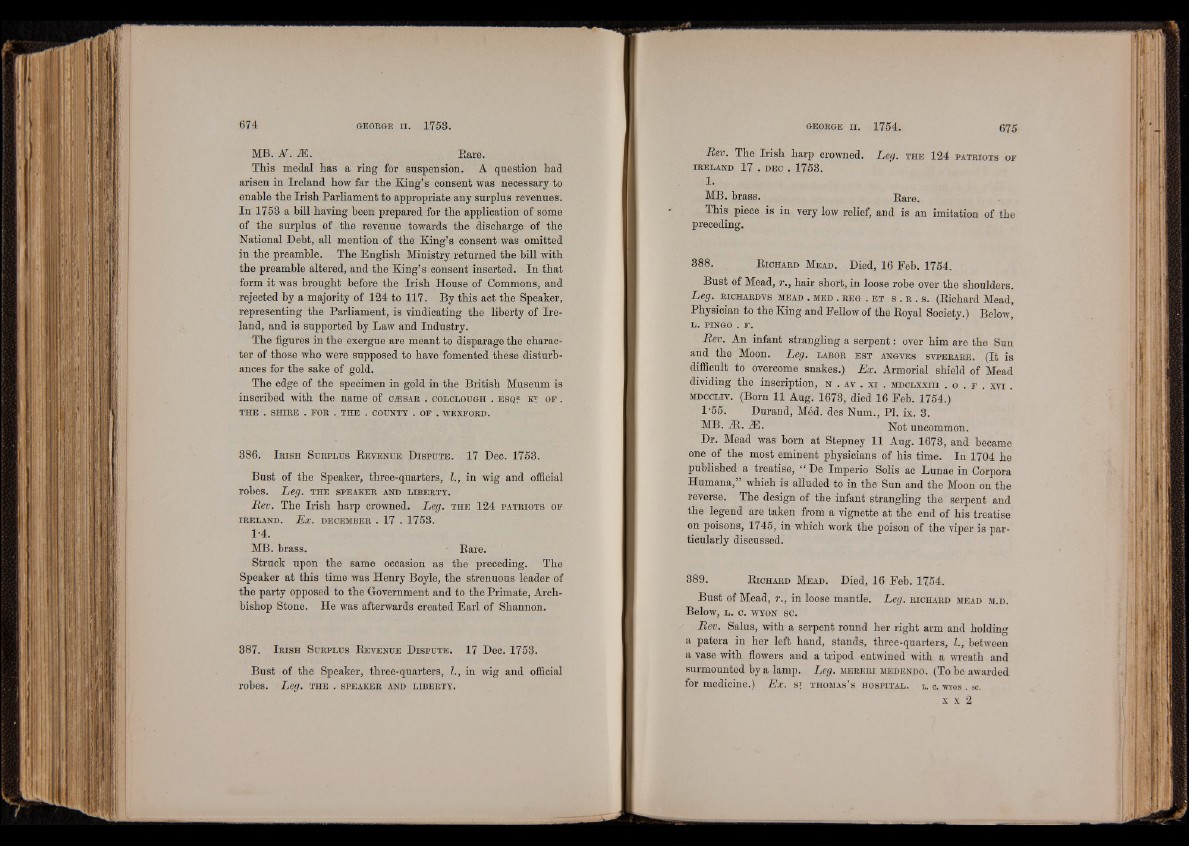
MB. N . M. Rare.
This medal has a ring for suspension. A question had
arisen in Ireland how far the King’s consent was necessary to
enable the Irish Parliament to appropriate any surplus revenues.
In 1753 a hill having been prepared for the application of some
of the surplus of the revenue towards the discharge of the
National Debt, all mention of the King’s consent was omitted
in the preamble. The English Ministry returned the bill with
the preamble altered, and the King’s consent inserted. In that
form it was brought before the Irish House of Commons, and
rejected by a majority of 124 to 117. By this act the Speaker,
representing the Parliament, is vindicating the liberty of Ireland,
and is supported by Law and Industry.
The figures in the exergue are meant to disparage the character
of those who were supposed to have fomented these disturbances
for the sake of gold.
The edge of the specimen in gold in the British Museum is
inscribed with the name of c js sa e . co lc lo u g h . e s q ? kt o f .
THE . SHIRE . FOE . THE . COUNTY . OF . WEXFOED.
386. I e i s h S u b p l u s R e v e n u e D i s p u t e . 17 Dec. 1753.
Bust of the Speaker, three-quarters, I., in wig and official
robes. Leg. t h e s p e a k e b and l ib e e t y .
Rev. The Irish harp crowned. Leg. t h e 124 pa t e io t s o f
IBELAND. Ex. DECEMBEK . 17 . 1753.
1-4.
MB. brass. * Rare.
Struck upon the same occasion as the preceding. The
Speaker at this time was Henry Boyle, the strenuous leader of
the party opposed to the Government and to the Primate, Archbishop
Stone. He was afterwards created Earl of Shannon.
387. I e i s h S u e p l u s R e v e n u e D is p u t e . 17 Dec. 1753.
Bust of the Speaker, three-quarters, I., in wig and official
robes. Leg. t h e . s p e a k e b and l ib e e t y .
Rev. The Irish harp crowned. Leg. t h e 124 p a t e io t s o f
IBELAND 17 . DEC . 1753.
1.
MB. brass. R a r e .
This piece is in very low relief, and is an imitation of the
preceding.
388. R ic h a b d M e a d . Died, 16 Feb. 1754.
Bust of Mead, r., hair short, in loose robe over the shoulders.
Leg. e ic h a e d v s m ead . m ed . e e g . e t s . e . s. (Richard Mead,
Physician to the King and Fellow of the Royal Society.) Below,
L. PINGO . F.
Rev. An infant strangling a serpent: over him are the Sun
and the Moon. Leg. labok e s t an g v e s s v p e b a b e . (It is
difficult to overcome snakes.) Ex. Armorial shield of Mead
dividing the inscription, n . av . xi . m d c l x x ih . o . f . xvi .
m d c c l iv . (Born 11 Aug. 1673, died 16 Feb. 1754.)
1*55. Durand, Med. des Num., PI. ix. 3.
MB. 2R. M. Not uncommon.
Dr. Mead was born at Stepney 11 Aug. 1673, and became
one of the most eminent physicians of his time. In 1704 he
published a treatise, “ De Imperio Solis ac Lunae in Corpora
Humana,” which is alluded to in the Sun and the Moon on the
reverse. The design of the infant strangling the serpent and
the legend are taken from a vignette at the end of his treatise
on poisons, 1745, in which work the poison of the viper is particularly
discussed.
389. R ic h a e d M e a d . Died, 16 Feb. 1754.
Bust of Mead, r., in loose mantle. Leg. e ic h a e d m ead m .d .
Below, l . c. wyon sc.
Rev. Salus, with a serpent round her right arm and holding
a patera in her left hand, stands, three-quarters, I., between
a vase with flowers and a tripod entwined with a wreath and
surmounted by a lamp. Leg. m e b e e i m e d e n d o . (T o be awarded
for medicine.) Ex. st Thom a s ’s h o s p it a l , l. o. wyoh.so.
x x 2